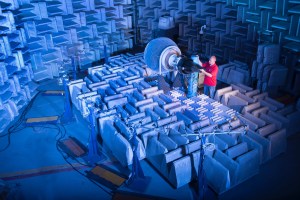Research scientists at NASA Glenn recently put cameras into a hot aircraft engine to help understand how ice builds up inside when exposed to ice crystal clouds. The cameras and other advanced instruments were mounted on a small section of the engine* internal flow path, where air passes through the engine, during a simulated experiment in the Propulsion Systems Lab.**
Ice crystal clouds can create rare but dangerous conditions in aircraft engines when flying at high altitude typically near convective thunderstorms. The Federal Aviation Administration has documented 230 cases of engine problems due to icing since the 1990s, such as the rollback of an engine, which occurs when ice builds up on the blade and creates a blockage and loss of thrust. Flameouts and damaged blades can also occur when chunks of ice break off the surface and enter the engine.
Understanding the risks and behavior of ice crystal icing is critical to developing safer technologies and procedures for the current fleet of aircraft in national airspace. Those discoveries can also be applied to future aircraft as NASA develops advanced aircraft technologies.
Footnote:
*This engine was an unmodified AL502 engine. Engines of this model have been modified to eliminate engine icing issues.
**This work was conducted under a collaborative Research and Technologies for Aerospace Propulsion Systems (RTAPS) contract effort with Honeywell. Honeywell supported this test through a collaboration with the Ice Crystal Consortium.






























